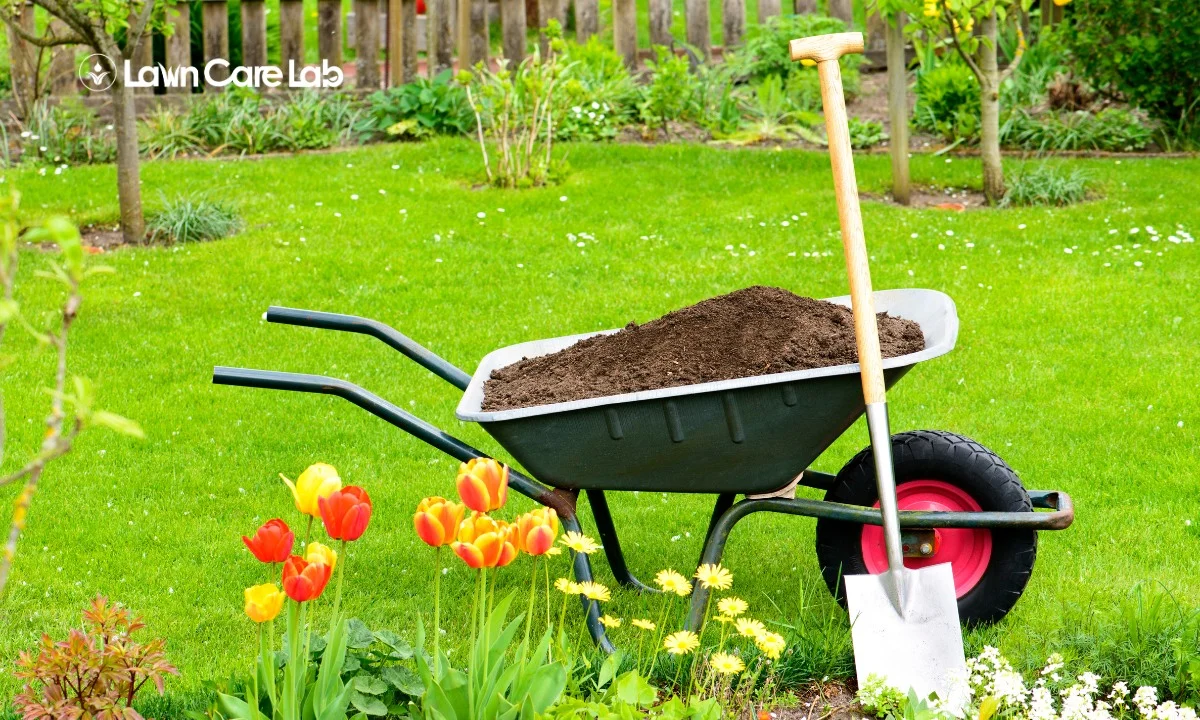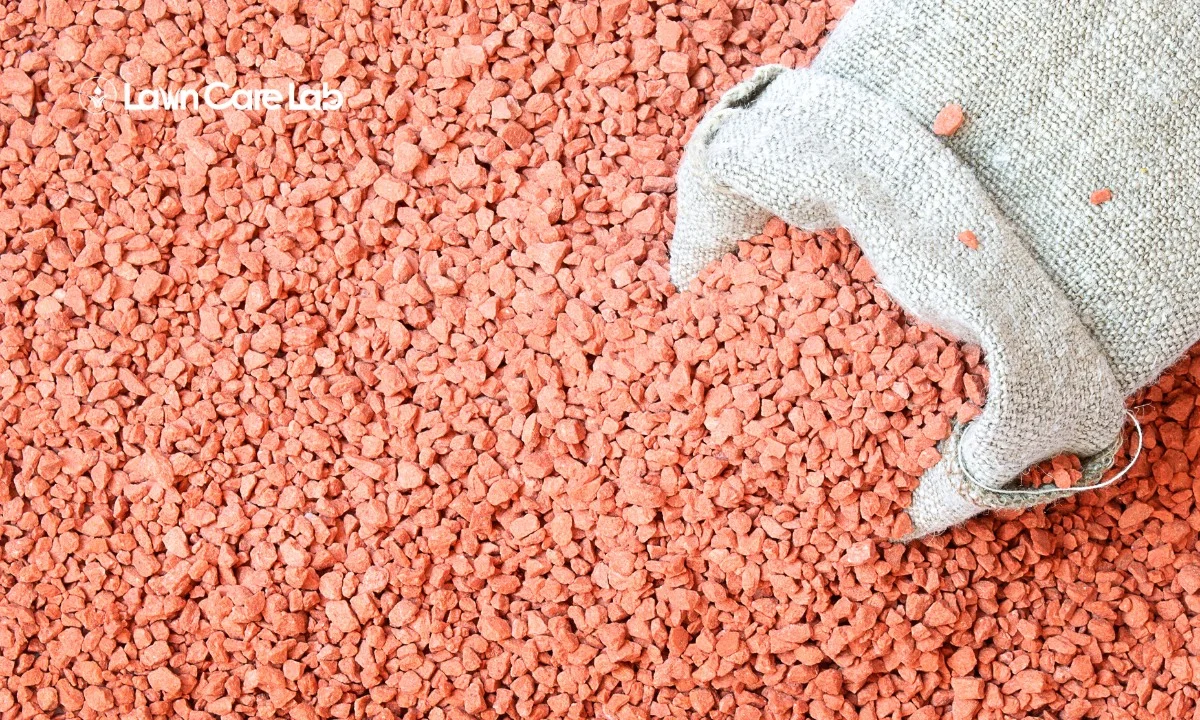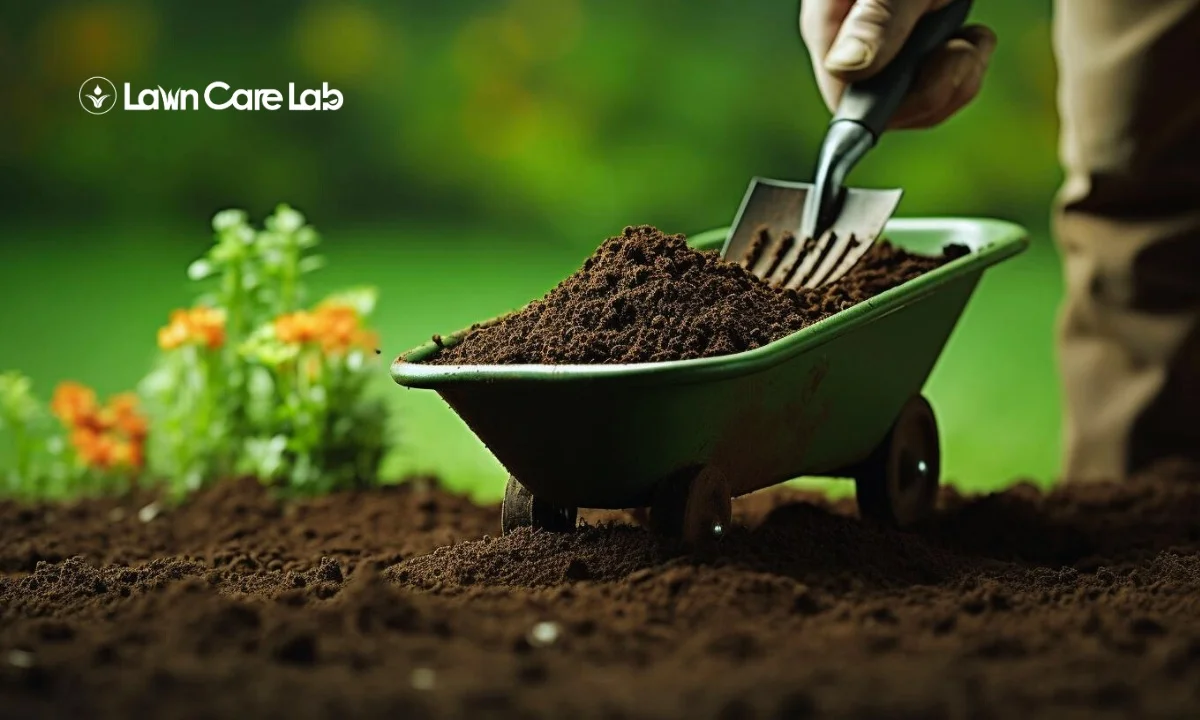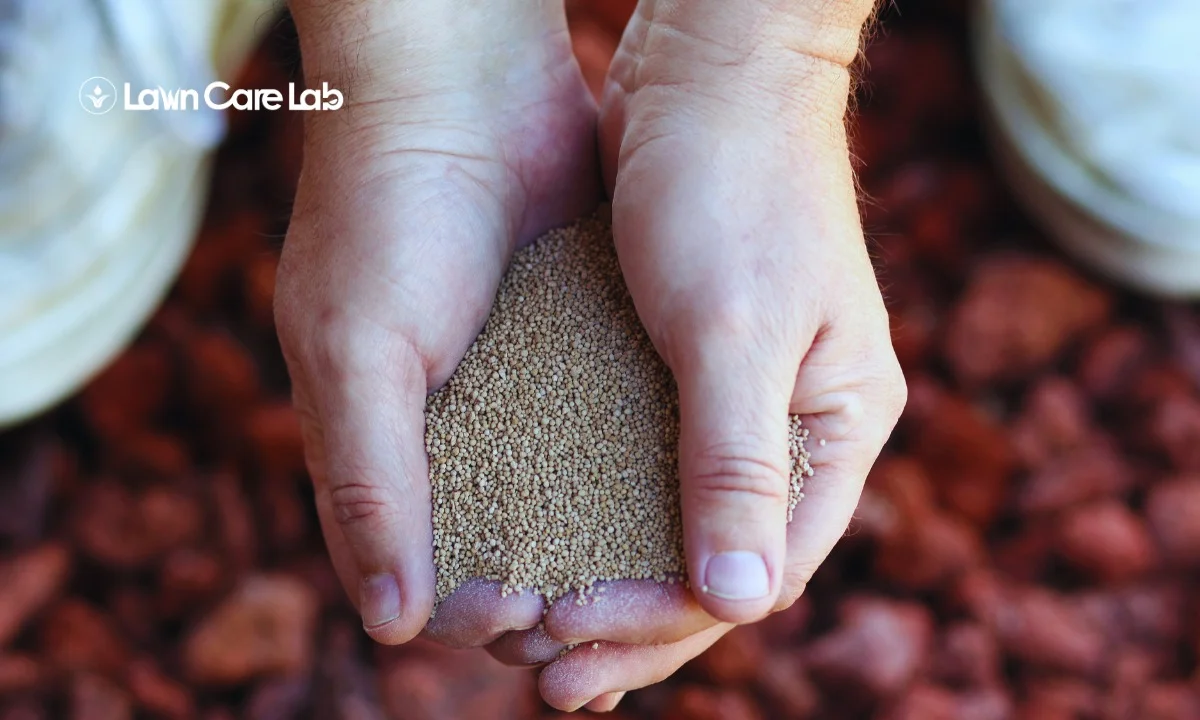Guess what? You’re sitting on a treasure trove, your very own compost! This ‘black gold’ has the power to revitalize your dull lawn into a lush green paradise.
This piece will guide you through the process of composting, shedding light on its advantages for your garden and effective ways to utilize it. We’ll also clear up any myths and provide solutions to potential problems.
So, are you set for a green makeover for your lawn? Let’s explore the magic of lawn health with compost fertilization.
Table of Contents
The Green Revolution in Lawn Care

You’re spearheading a paradigm shift in lawn care that prioritizes the environment and garden enhancement.
By rethinking your perspective on waste, you can tap into the hidden worth within your rubbish, converting it into a beneficial asset for your lawn.
The dual benefits: Environmental conservation and garden enrichment
Choosing compost fertilization for your lawn care isn’t just about achieving a green, thriving garden. It’s also about playing your part in environmental conservation. This eco-friendly approach reduces waste and minimizes our impact on the environment.
Plus, it enriches your garden soil with a myriad of nutrients for healthier plant growth. Ditching synthetic fertilizers in favor of composting is a sustainable gardening practice that promotes a beneficial microbial ecosystem in your soil.
Rethinking waste: The potential lying in our trash
Imagine this: nearly a third of your usual trash could be turned into compost full of nutrients for your yard.
This is what the Green Revolution in Lawn Care is all about – a clever shift in handling waste, leveraging the recycling perks of composting.
It’s a creative, eco-conscious method that turns your waste into a treasure trove of nutrients that enrich your lawn.
So, composting not only recycles but also enhances the health and vibrancy of your lawn.
It’s time we understood the basics of composting: transforming waste into wealth.
Composting Basics: From Waste to Wealth
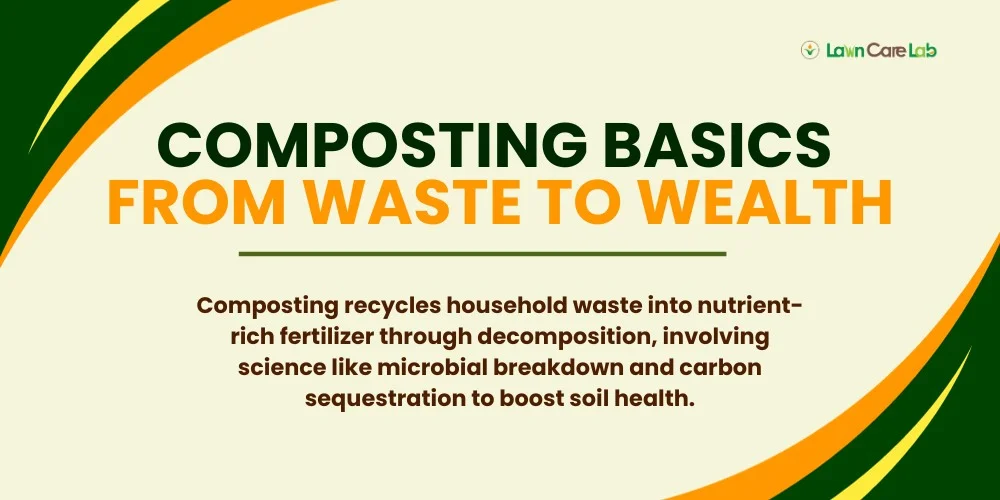
Have you ever wondered why gardeners refer to compost as ‘black gold’? It’s all down to the miraculous process that turns regular household waste into a nutrient-rich superfood for your garden.
Composting isn’t just about waste reduction, it’s a way to enrich your garden’s health and wellbeing. Once you get the hang of it, you’ll see its benefits.
What is compost, and why is it gold for gardeners
Compost, a nutrient-dense substance resulting from decomposed organic matter, is the secret weapon for a flourishing garden.
Grasping the decomposition process and the vital components of an effective compost heap is key to turning your trash into treasure.
The science of decomposition: Organic matter’s journey
Understanding decomposition can boost your gardening. It involves organic material breakdown, nutrient cycling, microbe activity, and carbon sequestration.
Together, these elements boost soil fertility, paving the way for a lush and bountiful garden.
Now that we’ve covered the science, let’s explore the crucial components of a successful compost heap.
Key ingredients for a thriving compost pile
Starting a successful compost pile might seem tricky initially, but it’s a breeze when you understand the essentials involved.
Ensuring a balanced carbon-nitrogen ratio, using suitable compost materials, and maintaining the right temperature are key. By getting a handle on these techniques, you can turn trash into a treasure for gardeners.
The trick is grasping the science and thinking outside the box when it comes to managing waste.
Benefits of Compost as a Lawn Fertilizer
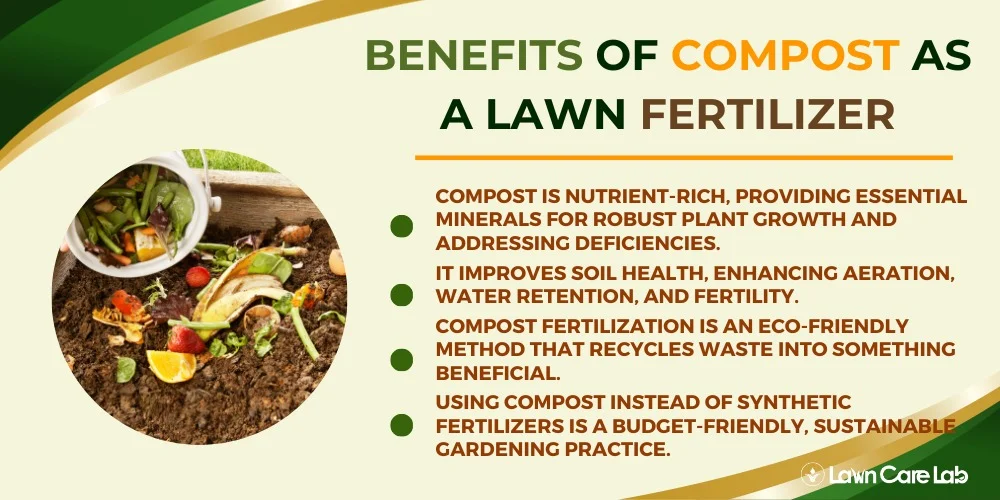
Wondering why compost is a great lawn fertilizer? It’s eco-friendly, budget-friendly, and nutrient-rich. Compost can be a game-changer for your lawn’s health and your wallet.
Nutrient-rich compost for vibrant lawns
Ever thought about turning your lawn into a lush, green carpet? Nutrient-packed compost can do the trick.
It’s a fertilizer and a soil enhancer that boosts aeration and water-holding capacity.
Plus, it’s a green way to recycle waste into something beneficial.
Essential minerals and their role in plant growth
Grasping the significance of essential minerals in plant growth is crucial to achieving a lush, healthy lawn using nutrient-rich compost as a fertilizer. Let’s break it down:
- The absorption process: this is how plants soak up necessary minerals.
- Addressing micronutrient deficiency: it’s about spotting and fixing nutrient imbalances.
- The pH factor: its impact on the availability of nutrients for plant growth.
- The organic vs. synthetic debate: weighing up the benefits and drawbacks for plant health.
Next, we will discuss soil aeration and how compost enhances water retention.
Soil aeration and improved water retention with compost
Composting is a game-changer for your garden, enhancing soil aeration and water retention, fostering robust plant growth, and fortifying against drought.
It ramps up soil fertility, championing the cause of organic gardening and sustainable farming practices.
Plus, compost serves as an eco-friendly soil enhancer that can transform your lawn into a lively, wholesome ecosystem.
Environmentally friendly and cost-effective gardening
Compost fertilization is a great green thumb technique for a vibrant, eco-friendly lawn. It’s a natural fertilizer that boosts soil health and plant growth. Plus, it recycles kitchen and yard scraps, reducing waste in landfills.
It also introduces good bacteria to the soil, aiding nutrient absorption. By using compost, you’re cutting down on chemical fertilizers, helping to protect our ecosystems.
How to Use Compost as a Lawn Fertilizer
Using compost as fertilizer for your lawn is a smart choice, but it requires careful preparation and maintenance.
Prepare your lawn by removing debris and weeds, testing and adjusting soil pH, and aerating the soil. Once your lawn is ready, apply compost evenly and water thoroughly. Regular mowing and fertilizing will keep your lawn healthy.
Preparing your lawn for compost application
Before you begin composting, checking your lawn’s soil is crucial. This will help you spot any nutrient shortages or pH imbalances.
The next step involves getting the turf ready by doing a bit of mowing, aerating, and dethatching. This preparation allows for easy compost integration.
Equally important are the timing and technique used for compost application, which can greatly impact your lawn’s well-being.
Testing soil health: Recognizing nutrient deficiencies
Before you start using compost, it’s essential to get a clear picture of your lawn’s current state of health and any nutrient shortages it may have.
This means you’ll need to:
- Identify signs of nutrient lack
- Use cutting-edge soil testing techniques
- Tweak the pH level to boost nutrient uptake
- Accurately decipher the results of your soil tests.
This thorough method ensures that your compost use perfectly aligns with the needs of your lawn, enhancing its overall wellness and vigor.
The right time and method for compost application
Knowing what your grass needs nutrition-wise is just the beginning. Now, we need to talk about when and how to use your compost fertilizer.
The key is to apply it either in spring or fall to ensure the nutrients are fully absorbed. It’s important to remember that the quality of your compost can greatly affect the overall health of your lawn.
Ongoing lawn care post-composting
Keeping your lawn healthy after composting requires a well-balanced routine. Regularly mowing ensures you maintain an appropriate grass height to avoid stress.
Adjust your watering habits to allow deep and less frequent watering, which encourages root development.
Regular soil testing is also crucial to keep track of nutrient levels and determine the frequency of composting.
The best time to apply compost is during spring or fall when your lawn is in its active growth phase.
Composting isn’t a one-off task but a continuous process that needs to be incorporated into your lawn care routine.
Common Misconceptions and Troubleshooting
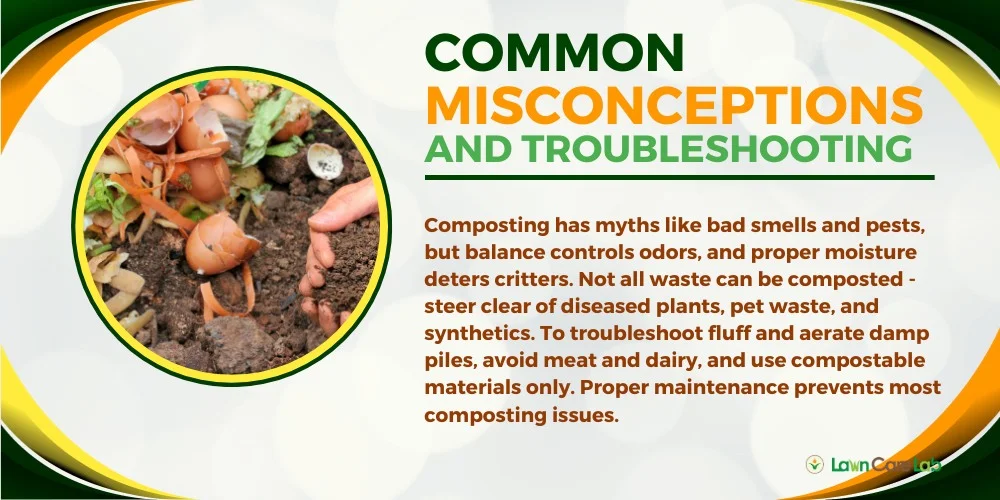
There are quite a few false notions floating around about composting that might leave you puzzled. Let’s clear up these misunderstandings and guide you through typical composting hurdles.
Debunking myths around composting
There’s a common misconception that composting is smelly, lures critters, or is just too complex. However, these are merely myths. Properly cared for, a compost heap doesn’t have any of these issues.
Although it’s an excellent method for recycling waste, bear in mind that not all materials are suitable for composting.
Addressing concerns of odor and pests
Contrary to popular belief, maintaining a balance in your composting methods can effectively control foul smells and pest issues. Proper aeration can be achieved with the right composting tools, while a mix of green and brown materials can help manage odors.
For pest control, ensure your compost is damp but not soaking. The rewards of composting are plentiful, including healthier soil and less waste. Just keep in mind that the key to successful composting lies in maintaining equilibrium.
Ensuring the right balance: Not all waste is compostable
To keep your compost pile balanced, it’s worth noting that not every type of waste can be composted, which often surprises many. Steering clear of adding things like sickly plants or animal waste can prevent hiccups in your composting journey.
Regular upkeep of your compost bin is the key to reaping its rewards.
Compostable items: plant matter, paper, food leftovers, untreated wood. Not compostable: weeds, diseased plants, pet waste, artificial materials.
Resolving common composting challenges
Composting can feel intimidating due to several misconceptions, but let’s clear those up and tackle some typical obstacles to make it a breeze.
If your compost heap has a bad smell, it’s probably too damp or lacking oxygen. Give it a good stir, let in some air, and balance the wetness with the dry brown stuff.
To prevent pests from invading, steer clear of composting meat, dairy, or sickly plants, and think about getting a bin with a lid.
Remember, not all waste belongs in the compost pile. Keep out the synthetic stuff and stick with organic waste.
To keep your compost in top shape, fluff it up periodically and keep an eye on the moisture levels.
Conclusion: Embracing Sustainable Lawn Care Practices
By tapping into the magic of composting, you’re set to adopt green lawn care methods that enhance your yard’s beauty and positively impact the environment.
This isn’t just a passing fad; it’s a groundbreaking strategy to tend to your lawn in harmony with nature. The ripple effects, from waste reduction to soil enrichment, show that we can balance aesthetics with sustainability.
Using compost as a powerful, natural fertilizer means you’re participating in a life cycle that boosts garden health, shrinks your carbon footprint, and propels us towards a more eco-friendly future.
- How to Create a Lawn Care Schedule for Southern Climates - October 30, 2024
- How to Use Compost Tea to Boost Lawn Growth and Soil Health - October 23, 2024
- The Best Grasses for Saltwater-Exposed Lawns: Coastal Lawn Care - October 17, 2024

